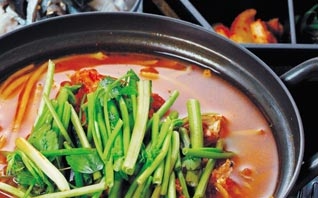Background on Korea's approach to food
Korean cooking has a distinct national identity that, in its contemporary form, combines dishes and techniques from both peasant diets and royal palace foods.
Korea is surrounded on four sides by water meaning that, beside rice, seafood is the staple food. The markets overflow with fish, shrimp, crabs, oysters, squid, and octopus which are eaten pickled, steamed and grilled. Fish is even stirred into a common breakfast porridge. As in Japan, rice, pickles and fish are the basis of the diet.
Food is flavored with various combinations of garlic, ginger, soy sauce, rice vinegar, sesame oil, dried anchovies and one of the many delicious spice pastes that Koreans build from a base of fermented soy beans. Koreans also eat meat; northerners eat more pork, while southerners prefer beef, and the cooks are unafraid to mix meat, fish, chicken and pork.
Both grain and rice are often made into noodles, which play a central role in Korean cooking. Soups, which come in a wondrous variety, are often noodle-based, and buckwheat noodles are distinctively local.
Much Korean cooking is done in a clay stewing pot known as a tukbaege. These produce gorgeous casseroles and stews that might combine fish or meat with potatoes, seaweed or tofu.
A meal is built around a mound of plain, steamed rice, which is eaten with thin chopsticks. A grilled or stir-fried main course is supplemented by a soup and perhaps a salad, along with an array of sauces, pickles, and other condiments. Kimchi is the most famous of these, a pickled, spiced vegetable. It is a part of nearly every meal, and its production is an ancient and revered art. The most famous kind of kimchi is made with napa cabbage, but it can also be made from radish and cucumber.
The vegetables or fish is pickled in a mixture that may include, among other things, coarse salt, chile, ginger, garlic, fish sauce, and water. The whole is sealed into an earthenware pot or jar to ferment until ready to eat.
The Koreans pay particular attention to the arrangement of the food on the plates and the dishes on the table, a similarity to first-class Thai cuisine. Foods are supposed to be placed neatly in concentric circles or parallel linear columns and never in a disorderly fashion.
Information courtesy Cuisinenet.com
